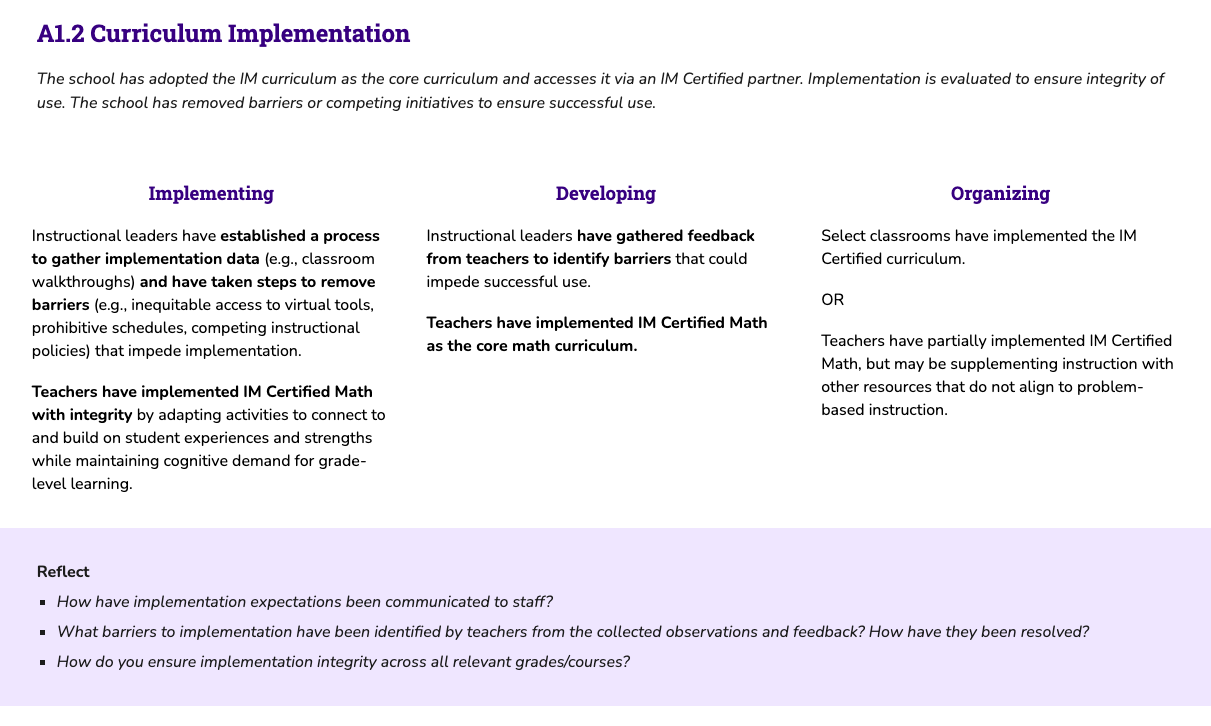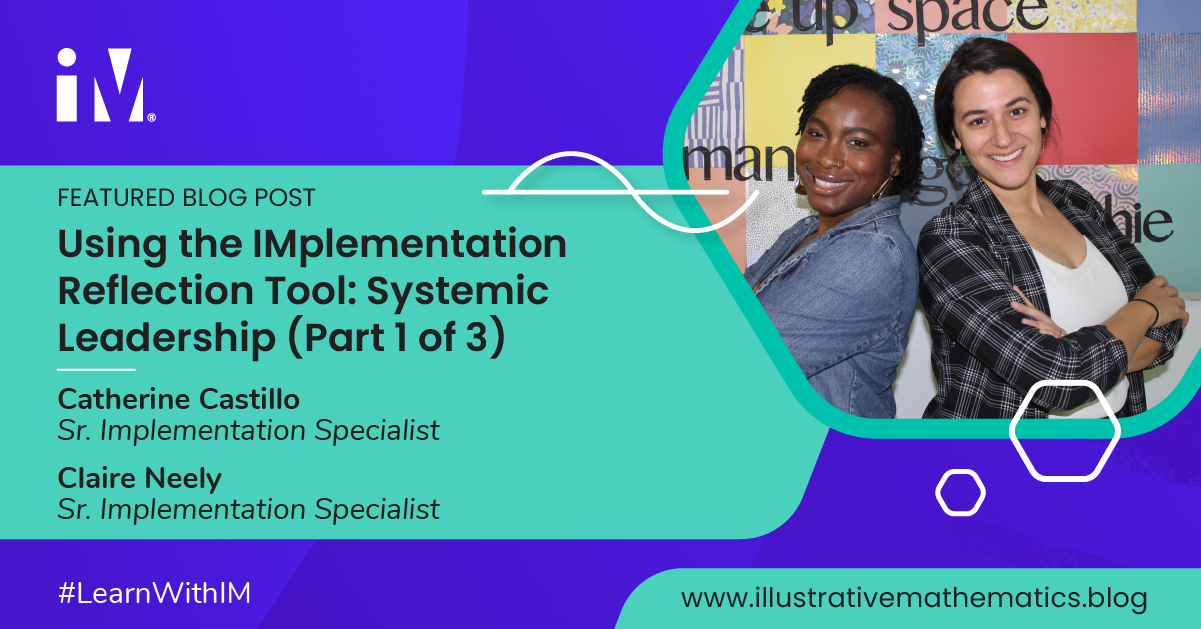Catherine Castillo, Sr. Implementation Specialist
Claire Neely, Sr. Implementation Specialist
“Given the critical role that school leaders play in supporting the development of coherent instructional systems at the school level, it is imperative to consider the forms of support and guidance school leaders need . . . to foster conditions that support teacher learning.”
On its own, access to high-quality instructional materials will not transform mathematics education. Successful implementation often depends on the actions leadership teams take before and during the adoption process. As previously outlined in the blog post Reintroducing the IMplementation Reflection Tool, Section A of the IMplementation Reflection Tool (IRT) provides explicit strategies and actions that support schools in leading IM implementation. Whether you’re piloting IM Certified® Math or are years into your implementation journey, the IRT can help your leadership team take concrete steps to strengthen the implementation process and improve learning outcomes for all students.
Getting Started
An effective implementation plan starts with aligning on a vision for math instruction. Leadership teams can begin this process by collaboratively reviewing, discussing, and assessing each indicator in Section A of the IRT.
For example, when reviewing A1.2 Curriculum Implementation, your team might determine that although teachers have implemented IM Certified Math as the core curriculum, you have not yet gathered feedback from teachers to identify implementation barriers. As a result, your current progress aligns with the Organizing stage in the progression, since only one of the two criteria required for the Developing stage has been fulfilled.

Doing this initial work collaboratively builds team investment and shared accountability. When you’ve agreed on your current placements for each indicator in this section, you’ve collected your first set of implementation data with the IRT and can decide where to prioritize your implementation efforts next.
Setting Priorities
Let’s consider the example of Southside Middle School. They’ve placed their school on each progression in Section A, as shown below.

What might be their next step to further their implementation journey? Consider which practices could be addressed relatively easily and which might take more time to implement. A1.2 and A1.4 stand out as areas ripe for growth, but the practices in those areas might be more challenging to implement. To clarify their course of action, Southside leaders turn to the reflection questions embedded in the IRT for A1.2.
How have implementation expectations been communicated to staff?
During their discussion, leaders realize that they’ve communicated mixed messages to teachers regarding curriculum usage. Some leaders advised teachers to follow the curriculum’s unit and lesson flow, while others recommended that teachers incorporate activities from IM Math lessons into existing lesson plans that they believe would resonate with their students. By identifying this disconnect, the leadership team can first establish a shared understanding of what implementation entails and then clarify those expectations with teachers.
What barriers to implementation have been identified by teachers from the collected observations and feedback? How have they been resolved?
The team exchanges a look as they each wait for one another to speak. They quickly realize no one had been tasked with surveying teachers, formally or informally, to understand the barriers to their classroom implementation. Recognizing this, the team assigns a leader to this task and collaborates on a system to record this data so that it can be systematically addressed by the team.
By taking the time to consider their progress together, identifying areas for improvement, and answering just three questions as a group, the leadership team at Southside Middle School has:
- developed shared expectations for implementing the IM Math curriculum,
- created a plan to clarify implementation expectations with teachers,
- identified a gap in their data collection process,
- refined roles for working with teachers to understand the barriers to curriculum implementation,
- and devised a system for recording teacher feedback in order to reflect and act on it as a team going forward.
By collaboratively tackling implementation challenges with the support of the IRT, leaders eliminate the guesswork typically involved in troubleshooting such a complex process. Instead, that time is dedicated to accelerating progress through the implementation journey.
Additional Strategies
Some leadership teams are small or have too many initial demands on their collaboration time to allow them to deliberate on all of the indicators in IRT Section A. In cases like these, identifying a few focus indicators and prioritizing growth in those areas can effectively drive continuous improvement in math teaching and learning. Selecting two to five indicators for a term that you believe will have a high impact on implementation is an excellent way to prioritize your support. At the end of the term, evaluate progress on those indicators. Once sufficient progress has been achieved for an indicator, select another indicator to replace it for the following term.
Alternatively, you might select three to five focus indicators to work on throughout the school year and chart your progress over time. How you leverage the IRT will be specific to your context and school needs. Rather than prescribe one right way to implement the IM curriculum, the IRT provides an outline of research-based practices to guide your implementation journey.
Conclusion
Implementing a curriculum with integrity requires strong, reflective leadership to drive a successful implementation process. Leaning into the leadership supports and structures outlined in the IMplementation Reflection Tool can clarify the areas of success and growth for your school, enhance your team’s collaborative practices, and streamline the implementation process for everyone.
Next Steps
- Access the IRT and use the reflection questions with your team to guide your conversations toward actionable, impactful next steps.
- Subscribe to the IM Blog to receive updates on upcoming installments in our implementation series.
- Connect with your IM Certified® partner to ask about our new IRT professional learning offerings.
- Share your implementation story or insight with us here–we’d love to hear from you!
Cobb, P., Jackson, K., Henrick, E., & Smith, T. M. (2018). Systems for Instructional Improvement: Creating Coherence from the Classroom to the District Office. Harvard Education Press.
 Catherine Castillo
Catherine Castillo
Sr. Implementation Specialist
Catherine Castillo (she/her) has spent her career supporting students and educators as a teacher, instructional math coach, math recovery intervention specialist, and district math coordinator. Catherine now serves as a senior specialist on the Implementation Portfolio team where she creates resources that support coaches and instructional leaders with IM implementation. Catherine is passionate about cultivating positive math identities in students and teachers and supporting the implementation of problem-based teaching and learning.

Claire Neely
Sr. Implementation Specialist
Claire Neely (she/her) received an MS in educational studies with a specialization in mathematics from Johns Hopkins University. Claire has spent her career in education teaching and coaching mathematics in schools of all kinds: Title I, charter, language immersion, traditional public, Montessori, K–8, middle, and high schools. After transitioning out of schools and into professional learning, Claire now serves as a senior specialist on the Implementation Portfolio team creating resources that support math coaches, curriculum specialists, and administrators with IM implementation.
